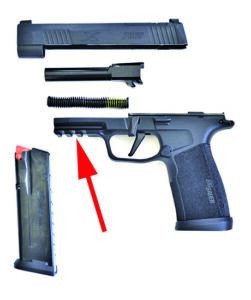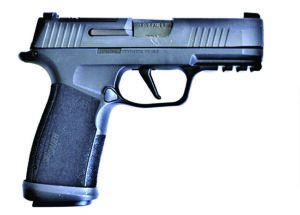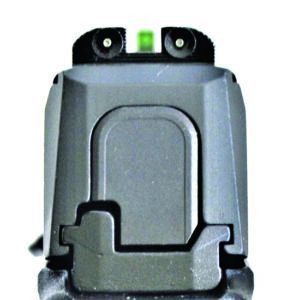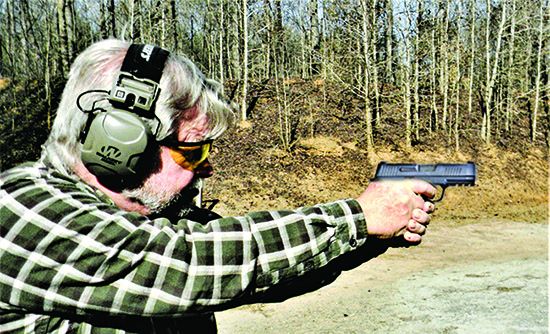Among the trends we have noted over the past decade is the replacement of the snubnose 38 Special revolver with the slim-line 9mm Luger pistol. Pistols such as the 9mm Smith & Wesson Shield and Glock 43 are the most popular pistols for concealed carry these days, but SIG took the platform even further with the SIG P365, a 10-shot 9mm with good reliability and practical accuracy. Other makers followed suit, including Smith & Wesson with the Shield Plus and Ruger with the Max 9. In this installment, we match up three comparable handguns, but each with different features. These makers have managed to stuff as many as 17 rounds into the magazine. Two offer a flush-fit magazine for pocket carry and an extended magazine for holster carry.
The FN Reflex is a different type of polymer-frame subcompact. It is a hammer-fired pistol with a concealed hammer. While similar in appearance to the archetypal 9mm striker-fired handgun, this is a different action type. The Reflex is a slim, compact pistol with good features and is both the smallest and the least expensive handgun tested here.

The Shadow Systems CR920 Combat Sub-Compact is more similar to the Glock 43 9mm than a Glock 26 9mm pistol in our opinion. The pistol is a high capacity version of slim-line handguns. Two magazines are supplied, one 10 round flush fit and one extended 13-round magazine. The pistol is short on ammunition capacity compared to the FN, but on the other hand, it is more compact as well. The pistol is only 1.05 inch wide.
The SIG Sauer P365 XMacro Tacops 365XCA-9-Tacops is very similar to the original XMacro in appearance. However it features a solid slide without compensator and a 3.7-inch barrel as well as forward and rear cocking serrations, X-Ray3 sights, and a well-designed grip frame with an excellent stippling treatment. The new light rail is longer than the original P365 and is more versatile in mounting lights.
Here’s what we thought of them in more detail.
SIG Sauer P365 XMacro Tacops 365XCA-9-Tacops 9mm Luger
$749
GUN TESTS GRADE: A- (OUR PICK)
Offered greater velocities with its 0.6-inch-longer barrel. Compared to the Shadow Systems and FN Reflex pistols, the Tacops is easier to shoot well but is a bit more difficult to conceal.

| Action Type | Semi-auto, single action, striker fired, short-recoil-operated lock breech |
| Overall Length | 6.6 in. |
| Overall Height | 5.2 in. |
| Maximum Width | 1.4 in. |
| Weight Unloaded | 22.8 oz. |
| Weight Loaded | 28.0 oz. |
| Slide | Stainless steel w/black nitron finish, front and rear slide cuts, M1913 rail, optics cut |
| Slide Retraction Effort | 16.0 lbs. |
| Receiver Material | Black polymer |
| Front Strap Height | 2.4 in. |
| Rear Strap Height | 3.2 in. |
| Barrel | 3.7 in. long carbon steel |
| Grip Thickness Maximum | 1.0 in. |
| Grip Circumference | 4.9 in. |
| Magazines | (4) 17-round steel |
| Rear Sight | X-RAY3 white tritium dots |
| Front Sight | X-RAY3 green tritium dot |
| Sight Radius | 5.6 in. |
| Trigger Pull Weight | 5.6 lbs. |
| Trigger Span | 2.5 in. |
| Safety | No manual safety |
| Warranty | Limited lifetime |
| Telephone | (603) 610-3000 |
| Website | SIGSauer.com |
| Made In | USA |
The price has dropped on this pistol compared to the original XMacro with compensator. The Tacops are also readily available at about a two-to-one ratio compared to the compensated version. Like the original XMacro, this pistol is based on the P365 action and its elongated version, the P365XL. If you like the long-slide XL, the P365 XMacro Tacops is more of a good thing.
The slide of the P365 XMacro Tacops is similar to the P365XL’s. The P365 XMacro was designed to offer higher capacity and excellent control. The XMacro’s taller grip frame accommodates a 17-round magazine. Four magazines are supplied with the pistol. An improvement over the P365XL is a grip frame that accepts different frame inserts. The new grip design makes the pistol more comfortable to fire, and a flared magazine well makes handling the pistol very fast during speed loads. Forward cocking serrations and SIG XRay3 night sights top off the pistol.
We liked the trigger action on the original very much. The trigger on the P365 XMacro Tacops breaks at 5.6 pounds, 0.1 ounce more than the P365 XMacro previously tested. SIG pistols are famous for consistency, still, this was impressive. In common with the original 17-round magazines tested, all four Tacops magazines were difficult to load to 17 rounds. A magazine-loading device, such as the UpLula is recommended. We followed previous procedure and loaded the magazines to 15 rounds for most of the testing.

We fired the pistol on the combat course at 5, 7, and 10 yards. The pistol fired the 115 FMJ loads without a single failure to feed, chamber, fire, or eject. The SIG P365 XMacro is easily the most controllable pistol of the three. It is also the heaviest handgun, although it is not a heavy gun. The grip frame also has bearing on the pistol’s accuracy in combat firing.
Fired for accuracy, the SIG P365 XMacro Tacops was easily the most accurate of the three pistols, with groups consistently in the 1.5-inch range. Coupled with the pistol’s easy shooting on the combat range, the SIG is easily the best-shooting pistol of the three — although the others were exceptional shooters for subcompact 9mm handguns. We would prefer the SIG to the other two handguns if price is no object and we could conceal the slightly larger handgun.
Our Team Said: The SIG P365 XMacro Tacops has the greatest capacity, the best sights, the best combat accuracy, and the best bench accuracy. Reliability is faultless. Recoil is modest. It is an exemplary concealed-carry pistol. If you are able to conceal this pistol — and it isn’t that big of a gun — you should choose it.
For some, however, the trigger action of the Shadow Systems is a better choice for pocket carry. The SIG P365 XMacro Tacops isn’t a good choice for pocket carry except for crews and some jacket pockets. In the end, if price is no object, we’d pick the SIG 9mm as a smaller carry gun. If space is limited and deep concealment needed, then we’d go with the FN Reflex.
| 9MM LUGER RANGE DATA | |||
| Remington HTP 115-grain JHP | SIG Sauer P365 XMacro Tacops | Shadow Systems CR920 Sub-Compact | FN America FN Reflex |
| Average Velocity | 1160 fps | 1144 fps | 1150 fps |
| Muzzle Energy | 344 ft.-lbs. | 334 ft.-lbs. | 338 ft.-lbs. |
| Small Group | 1.1 in. | 1.5 in. | 1.4 in. |
| Average Group | 1.5 in. | 2.0 in. | 2.0 in. |
| Federal Premium 124-grain HST JHP | SIG Sauer P365 XMacro Tacops | Shadow Systems CR920 Sub-Compact | FN America FN Reflex |
| Average Velocity | 1139 fps | 1120 fps | 1107 fps |
| Muzzle Energy | 357 ft.-lbs. | 345 ft.-lbs. | 337 ft.-lbs. |
| Small Group | 0.9 in. | 1.3 in. | 1.1 in. |
| Average Group | 1.4 in. | 1.6 in. | 1.5 in. |
| Black Hills Factory New 124-grain JHP +P | SIG Sauer P365 XMacro Tacops | Shadow Systems CR920 Sub-Compact | FN America FN Reflex |
| Average Velocity | 1183 fps | 1140 fps | 1160 fps |
| Muzzle Energy | 385 ft.-lbs. | 358 ft.-lbs. | 370 ft.-lbs. |
| Small Group | 1.0 in. | 1.3 in. | 1.3 in. |
| Average Group | 1.5 in | 1.8 in. | 1.7 in. |
We fired groups at 15 yards from a benchrest position using an MTM Case-Gard K-Zone Shooting Rest. We used a Competition Electronics Pro Chrony to measure muzzle velocities.
Written and photographed by Gun Tests Staff, using evaluations from Gun Tests Team members. GT



























